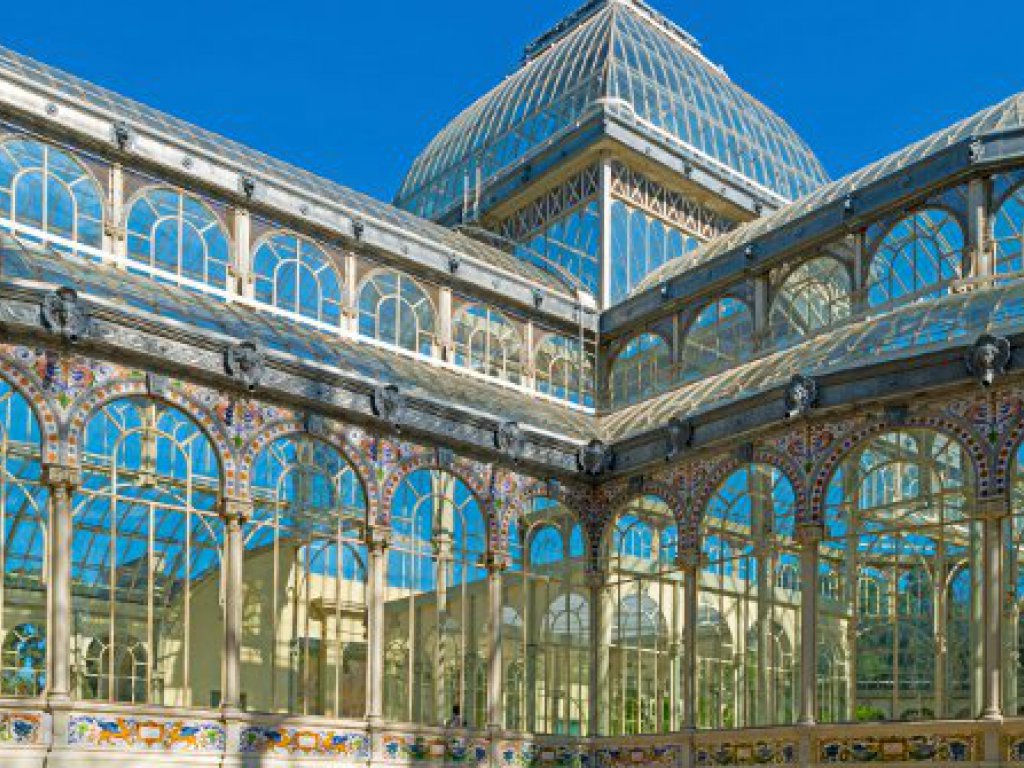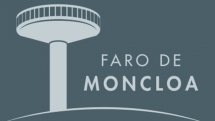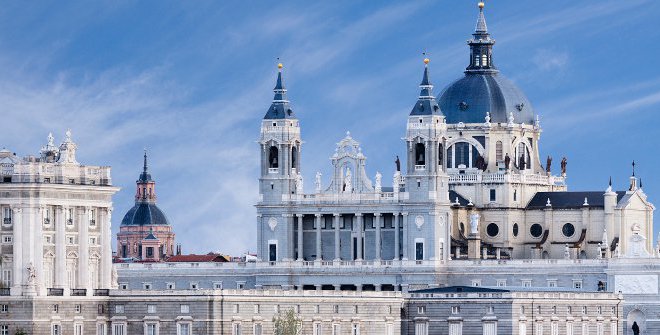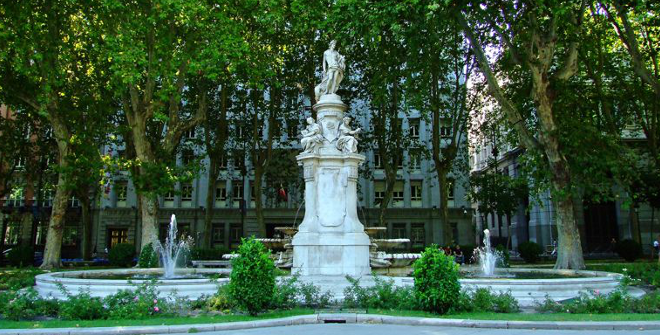Madrid, an open air museum
Madrid is full of art. Its museums are renowned worldwide, but you can also enjoy monuments and many architectural and artistic details on the city’s streets without having to step inside a museum. Take a leisurely stroll from El Retiro Park to Plaza de España (2.4km along the Gran Vía; 3.2 km along Sol and Arenal 3.5 km along Sol and Mayor) and discover them.
Our route kicks off in El Retiro Park, which is home to small architectural treasures, such as the ruins of the Chapel of San Pelayo and San Isidoro, the famous statue of The Fallen Angel, or the Crystal Palace. Exiting through the Royal Gate, we come to the emblematic Puerta de Alcalá, located in the centre of the Plaza de la Independencia.

From Plaza de Cibeles to Calle de Alcalá
Going down Calle de Alcalá, we reach Plaza de Cibeles, where you must take a photo of its iconic fountain and the spectacular Cibeles Palace. Shortly afterwards, you will get to the Cariátides Building, headquarters of the Cervantes Institute.

On the opposite side of the street, there is the Circle of Fine Arts with its impressive six-metre tall Minerva on the rooftop and at the junction of Alcalá with Gran Vía, you will see the Metrópolis Building and its statue of the Winged Victory where, you must decide whether....
... to continue along the Gran Vía...
In the building that used to house the Hotel Roma, you will come across the visual spectacle of the WOW Concept megastore. A little further along and on the other side of the road, you can admire the unique silhouette of the Caballero de Gracia Royal Oratory.
On reaching Calle Montera, you will be surprised by the beauty of the temple entrance to the Gran Vía metro Station, a replica of the original created by Antonio Palacios, who was also responsible for the Cibeles Palace.

Continue until you reach the Primark flagship store and lower your gaze. You will see some mysterious arrows set into the pavement. To find an explanation for them, you will see that a spectacular sculpture of Diana the Huntress goddess rises up from the cornice of Number 31 Gran Vía with a bow in one hand pointing towards the building opposite. Her target seems to be the sculpture of the Union and the Phoenix that crowns the rooftop of Gran Vía 32, by which Diana feels threatened.
Close to the Plaza del Callao, the lower floors of the Music Palace reveal a mural by the artistic duo, Los Bravu. Made out of typical tiles from Madrid and based on a mixed technique drawing, it pays tribute to culture and the environment.
Now in the plaza, it is impossible not to look up at the Carrión Building, better known as the Capitol Building. This popular art déco building, has a Schweppes neon light advertisement, which has become one of the symbols of Madrid. It is flanked by another two beautiful buildings: Callao Cinema and the Press Palace.

Going down towards Plaza de España, one of the most eye-catching buildings on this street is located at Number 68, Gran Vía: La Unión y El Fénix building, crowned by a large black dome and a sculpture of the Phoenix Bird.
... If you choose to go along Calle de Alcalá to Sol
At 16 Calle de Alcalá, you will come across the emblematic “chariots building”, known popularly by this name due to the two chariots pulled by horses on its rooftop. Former headquarters of the BBVA, it is now the headquarters of the Department for the Environment and Territorial Planning. Nearby, at 15, Calle de Alcalá, the majestic building of the Royal Casino of Madrid rises up, an example of Madrid’s early 20th century eclecticism.

Plaza de Canalejas is between Calle Alcalá and Calle Sevilla, whereby its buildings are not to be missed along our route thanks to their immense historic, architectural and cultural value. The Canalejas Building is a clear example of the co-existence of the old and the contemporary with its façade featuring beautiful architectural details. This complex is home to the Four Seasons Hotel Madrid and the exclusive Galería Canalejas.
We have now reached the Puerta del Sol which concentrates several of the city’s most representative elements: the Post Office clock, headquarters of the Community of Madrid; the Tío Pepe advertising sign high above number 11; and the equestrian statue of Charles III.
At the end of this section, between Puerta del Sol and Plaza de Jacinto Benavente, in Calle de La Paz, is the UMusic Hotel Teatro Albéniz. Its façade is home to eight of the original eleven wooden sculptures by the sculptor, Ángel Ferrant.
...and if you continue along Calle Arenal....
Within 350 metres, you will come across San Ginés Church, which boasts a fantastic painting by El Greco. In the Plaza de Isabel II, we can find the Teatro Real and its curious hexagonal building.

Ten metres down the Plaza de Isabel II, Ópera Metro Station is home to the museum recreation of the historic Los Caños del Peral fountain, Amaniel aqueduct and Arenal sewers.
... if you choose to go along Calle Mayor...
500 metres from Sol, is the San Miguel Market, a beautiful example of iron architecture, turned into a gastronomic market. On the rooftop of 3 Calle de los Milaneses, you will be able to admire the Fallen Angel of Milaneses, an impressive statue, known as “Air Crash”.
A little further on, in the middle of the Plaza de la Villa, centre of medieval Madrid, you can find the Tower and Houses of the Lujanes, the oldest civil building in Madrid.
Reaching the end of the street, at the crossroads between Calle Mayor and Calle Almudena, it is time to stop and have a look at the archaeological remains of the Santa María de la Almudena Church. This is where the bronze statue of the Curious Neighbour can be found, looking over the railing from where the archaeological remains can be seen.

Turning into Calle Bailén, in the heart of Habsburg Madrid, we can find the impressive Almudena Cathedral, of which the Neo-romanic crypt stands out and its dome, which offers impressive views.
Next to the cathedral is the Palacio Real, the largest in western Europe, it is one of the most visited places in the city. Nearby, is the Palacio Real’s Cornise Lookout , offering some beautiful views of the Campo del Moro Gardens and the Casa de Campo. Have a look around its neighbouring Plaza de Oriente, enjoy the much photographed equestrian statue of Philip IV and discover the statures of the Spanish kings that were intended to decorate the cornice of the palace.

If you look towards the Plaza de España, you will see the original Byzantine dome decorated with polychrome tiles of the Church of Santa Teresa de Jesús and San José.
Continuing along the route, you will come across the Palace of the Marquis of Grimaldi or Godoy (whose stables, appeared during the Plaza de España refurbishment works can be made out behind a skylight), remains of the former wall, the Senate and the beautiful building of the Real Compañía Asturiana de Minas.
End of the route, Plaza de España
Your route full of art has come to an end, but you still have time to admire the Monument to Miguel de Cervantes, featuring the characters of Don Quixote and Sancho Panza; two impressive skyscrapers (Torre de Madrid and Edificio España) and, finally, in one of the corners of the square, Casa Gallardo, one of the major works from the final stage of Madrid’s modernism.




















